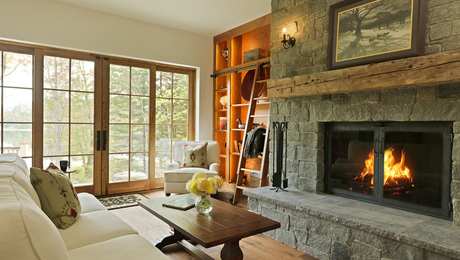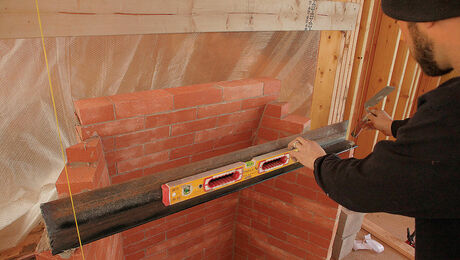Of these two options only, housewrap and tarpaper, which is the better choice for cedar sidewall shingles applied over CDX and why?
-Mike

There are several reasons indoor fireplaces aren't the best choice for an energy efficient home.

"I have learned so much thanks to the searchable articles on the FHB website. I can confidently say that I expect to be a life-long subscriber." - M.K.
Get home building tips, offers, and expert advice in your inbox

Dig into cutting-edge approaches and decades of proven solutions with total access to our experts and tradespeople.
Start Free Trial Now
Get instant access to the latest developments in green building, research, and reports from the field.
Start Free Trial Now
Dig into cutting-edge approaches and decades of proven solutions with total access to our experts and tradespeople.
Start Free Trial NowGet instant access to the latest developments in green building, research, and reports from the field.
Start Free Trial Now© 2025 Active Interest Media. All rights reserved.
Fine Homebuilding receives a commission for items purchased through links on this site, including Amazon Associates and other affiliate advertising programs.
Get home building tips, offers, and expert advice in your inbox
Become a member and get instant access to thousands of videos, how-tos, tool reviews, and design features.
Start Your Free TrialGet complete site access to expert advice, how-to videos, Code Check, and more, plus the print magazine.
Already a member? Log in
We use cookies, pixels, script and other tracking technologies to analyze and improve our service, to improve and personalize content, and for advertising to you. We also share information about your use of our site with third-party social media, advertising and analytics partners. You can view our Privacy Policy here and our Terms of Use here.
Replies
Boy are you lookin for it!! Did someone pay you to make this post??
Eric
Felt.
Tannins in cedar effect Tyvek in a bad way. Of course, if you back prime (which is good practice anyways), it probably matters less, though I still rate felt as the better material.
The best design is [arguably] a rainscreen, in which the shingles do not contact the 'secondary weather barrier' at all.
Thanks.
By the way, do you know how the Tyvec is affected?
-Mike
FYI, the reason Firebird replied the way he did (not to put words in his mouth, but, you may have been surprised) is that this topic was discussed ad infinitum a couple days (weeks?) ago. I think someone at that time said you can read about Tyvek on its web site and it warns that installing under cedar is detrimental due to the affect of tannin from the cedar. May even say it on instructions that come with it.
My neighbour had a major reno done last summer. Removed old brick, wrapped house in Tyvek and had cedar - un-backprimed - put directly over the Tyvek.
Builder was bragging to me that he was expensive but good. Was he oblivious?
You may have wanted to direct your reply/question to csnow, but since it came to me, I'll try to reply: Lot's of builders don't keep up with the latest info--probably too busy building. I, myself, didn't know about cedar doing bad things to Tyvek until I read about it on this forum. And, everything may be okay, but I understand that the manufacturer of Tyvek warns against installing it under cedar. Most posters here say that felt (tarpaper) is the better option with cedar. Time will tell.
The tannins in cedar behave like surfactants (detergents are another example), which affect the surface tension of molecules, allowing them to become wet. In a nutshell, tannins make housewraps leak. Tannins have a similar effect on felt, however, because felt is thicker, it lasts much, much longer.
FWIW, I recently tore off some unbackprimed cedar from a house built twenty years ago. The Tyvek was shot.
AndyArguing with a Breaktimer is like mud-wrestling a pig -- Sooner or later you find out the pig loves it.
"If indeed there is a problem with Tyvek, I wouldn't think it would exist with Typar and other such housewraps that are essentially a thin felt with a microperforated "waterproof" coating."
Perforated housewraps tested poorly as a secondary weather barrier.
http://www.umass.edu/bmatwt/publications/articles/leaky_housewraps.html
http://www.umass.edu/bmatwt/publications/articles/housewraps_feltpaper_weather_penetration_barriers.html
Yeah, but the complaint against Tyvek is that it loses it's water resistance behind cedar. The others at least would be a known quantity.
(My preference is Tyvek wherever possible, however.)
Edited 8/5/2004 12:26 pm ET by DanH
Can someone do me a favor and post here, maybe get this thing off my "to me" list?
here's at ya....BTDT
Spheramid Enterprises Architectural Woodworks
Repairs, Remodeling, Restorations.
What happens when it's on your 'to me' list?
Why on earth would rosin paper be used under cedar shakes on the east side of the house and black felt paper be used on the south side of the house?
Just discovered this today while I was stripping/sanding and painting the south side.Perfect beef stew, perfect meatloaf and perfect wine jelly.How difficult can perfecting creme brulee be?
saran wrap or wax paper...keeps the cedar smellin good longer
Spheramid Enterprises Architectural Woodworks
Repairs, Remodeling, Restorations.
I'll let you know in a few years what happens to Tyvek under cedar.
The secret of Zen in two words is, "Not always so"!
http://CLIFFORDRENOVATIONS.COM
Well, in my case, they used rosin paper (1926 - at least I think it's rosin paper...thin papery stuff with a faint pink tinge to it). For half a second, I contemplated removing the shakes, putting on 30lb roofing paper and putting the shakes back on but I would like to FINISH painting the house. sigh
Priorities change. FIRST is a Hyster manlift and now tied at second is money and acreage.
Regardless, do as csnow suggested and back prime or dip em. Also use home slicker to let the wood breath. Its a three dimensional nylon matrix that keeps the shingles a 1/4" off the building paper. Both tips make a world of difference in the longevity of the finish.
To all-
Thanks for the information. I apologize if the question was a familiar one on this forum, but I appreciate the advice.
-Mike
Well, look at the very bottom of this page:
http://construction.tyvek.com/en/constrSystems/builders/builderFAQs.shtml
Thanks Dan,
Interesting that Dupont would state;
"Yes, Tyvek¯ can be used under cedar siding. It is recommended that the cedar siding be installed per manufacturer’s guidelines and recommendations by wood siding associations, such as the Western Red Cedar Lumber Association, including priming all surfaces including the back and ends before installing. Additionally, the use of furring strips will help promote drainage of any incidental water that may penetrate the cedar cladding."
Dupont seems to contradict most of the breaktime replies. Perhaps a combination of Tyvek (or other housewrap) and Home Slicker is the best route.
Thanks again-
Mike
If indeed there is a problem with Tyvek, I wouldn't think it would exist with Typar and other such housewraps that are essentially a thin felt with a microperforated "waterproof" coating.
DanH
Yeah, I think you are correct. I also suspect that Tyvek works just fine as long as moisture is not trapped behind the shingles. (To conclude otherwise would be to assume that DuPont was willing to knowingly adopt a huge liability down the road.) My guess is that where traveling moisture is a problem, tyvec works too well and traps the moisture behind the siding rather than letting it disperse back into the house. So it seems to me that as long as the back of the siding can breathe, it is ok to go with a house wrap.
As a framer, I have no real experience with siding and house wraps. My goal was to create as tight an envelope as possible without running into problems with shingle lifespan. Because I had heard a lot of talk about the incompatibility of house wrap and shingles, I thought I would test the subject on breaktime.
I suspect all the bad house wrap PR began about the time homes became insulated- the back side of the shingles could no longer breathe and house wrap made the condition even worse. Old timers saw old houses (non-insulated) with tar paper working just fine and new (insulated) houses with house wrap and failed siding. Perhaps they concluded that it was the house wrap that was to blame rather than the fact that wood siding needed to be able to breathe when applied to a thermally sealed modern home.
Just a guess.
-Mike
I think that this is a subject of great controversy. I am renovating a house with white cedar shingles, 3o lb. corner splines, Vycor window splines and a composite watertable. I have done this on lots of houses over the past 15 years and never had call backs or complaints but these were not painted or stained. I also recently did a couple of pre stained shingle jobs and the salesman at the lumber yard said that the cedar breather was a waste of time and money on sidewall.
A question on the breather, i used it on one red cedar roof but otherwise unfamiliar. Does the breather go on like house wrap, under cornerboards and window trim,if not wont the siding build out past the trim?
woodbutch777:
Here is a link to home slicker install info. Accoding to the manufacturer, the product can be either butted against the trim or run past it.
http://www.benjaminobdyke.com/html/products/inst/inst_slick_wo.html
-Mike